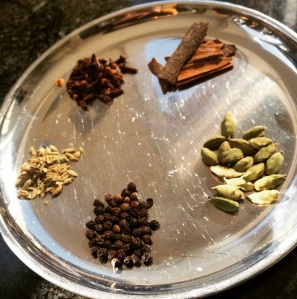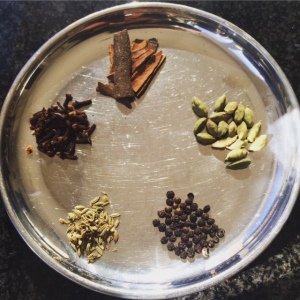By now I think everyone is fast becoming aware of the option of swapping your normal latte for a ‘chai’ latte at your local coffee shop. Having a warm chai is also a favourite on the alternative festival scene. To me, it is such a normality to have a tin of masala next to the tea bag caddy in the kitchen. With something that is so close to home and is growing expansively in popularity, I sought to learn more about this hot drink that I have for years been consuming yet remaining quite ignorant about!
First things first, let me just clear up one important detail about the word chai. In Hindi, chai is the literal translation of tea. So when you ask for a chai tea, you are asking for a ‘tea tea’! The word chai has taken on its own meaning here in the West, and personally I feel this is okay – everybody is enjoying it, so no problem!
 Masala chai is an aromatic beverage that you’ll find being mainly consumed in India, but also expands to other Eastern areas of the world. It is basically like a spicy tea. Here in the West we drink chai in a more recreational way, however, historically it was used more so as a medicinal drink due to the properties of the spices that are included in the brew.
Masala chai is an aromatic beverage that you’ll find being mainly consumed in India, but also expands to other Eastern areas of the world. It is basically like a spicy tea. Here in the West we drink chai in a more recreational way, however, historically it was used more so as a medicinal drink due to the properties of the spices that are included in the brew.
There are so many cultural practices that can be explained by their functionality. I think it is beautiful how this functionality ties into culture, serving a purpose as well as embodying the spirit and essence of the culture; forming an identity for those of the culture within the functional practice.
Masala Chai is brewed with black tea leaves and a mixture of aromatic and medicinal spices. It is best enjoyed sweetened and with milk added too. The spice mix is also known as the karha. This mix can vary depending on who you speak to. This particular karha that I am about to explain is from my lovely mum who grinds and makes her own fresh mix.
So what makes masala chai so functional? It’s all in the spice…
 1. Cinnamon (Cinnamomum verum & Cinnamomum cassia)
1. Cinnamon (Cinnamomum verum & Cinnamomum cassia)
Cinnamon is known as a wonder spice for its many beneficial properties. Key benefits of cinnamon include its ability to lower blood sugar levels, which makes it fantastic for sufferers of diabetes. It does this by increasing the body’s sensitivity to insulin, a key hormone in blood sugar regulation. It also has anti-inflammatory properties as well as having a cholesterol lowering effect. The inner bark of the tree species is high in a compound called cinnamaldehyde which is responsible for its medicinal effects on the body. In order to obtain the full benefits of cinnamon, you need to be consuming around 1-6 grams a day (half to two teaspoons).
There are two types of cinnamon, and I feel that it is quite important that we are aware of the difference between them. Cinnamomum verum, also known as ceylon cinnamom is ‘true cinnamon’. The other variation, which is more widely and cheaply available (the cinnamon you buy at regular supermarkets) is called Cinnamomum cassia. This species is particularly high in a compound called coumarin. Due to the involvement of coumarin in blood clotting, too much of this species is quite risky. So do source your cinnamon carefully!

2. Cardamom (Elettaria cardamomum)
Cardamom is another wonder spice. As well as being used culinary for its intensely beautiful aroma, it also has an important role in Ayurvedic medicine. Cardamom belongs to the plant family Zingiberaceae – the same family of ginger and turmeric. It seems this plant family has something really special about it! I will save talking about the benefits of turmeric and ginger for another post, but lets just say they are in my top five most important foods to be consuming for their all round health benefits. Cardamom is the seed pod of the plant species. The spice contains a high level of the compound methanolic acid which allows for its role in aiding gastrointestinal disorders, gastric acidity, flatulence and stomach cramps. In Ayurveda it is widely prescribed in treating infections of the teeth and gums and oral mucosa (mouth ulcers).
 3. Fennel seed (Foeniculum vulgare)
3. Fennel seed (Foeniculum vulgare)
This aromatic spice is most beneficial for its high fibre content. The compounds kaempferol and quercetin give fennel its anti-oxidant benefits which make it a great spice for anti-ageing and anti-cancer effects. The essential oils of fennel seed have a carminative effect, meaning that they aid in lowering the formation of intestinal gas, making it a great spice for digestion.
 4. Clove (Syzygium aromaticum)
4. Clove (Syzygium aromaticum)
This aromatic spice is the dried form of the unopened flower bud from the clove tree. Clove contains high levels of a compound called eugenol which is a potent anti-inflammatory. In combination with another compound, beta-caryophyllene, clove makes a fantastic anaesthetic and antibacterial agent hence the traditional use of clove oil for toothache.
A good quality clove will release some of its oil content when rubbed. Another useful test is to place a single clove into a cup of water and see how it floats. If it floats horizontally you’ve got a good quality spice. If it sinks or floats vertically, it is not the best quality.
We all use a bit of pepper to add to taste to our food, but this fiery spice also has a function in that it aids in good digestion. Peppercorns, like fennel seeds, have a carminative effect on the intestine. The peppercorns we use are actually dried berries of the plant species. The spice also has diaphoretic (creating sweat) as well as diuretic (promoting urine flow) properties. The outer layer of peppercorns also stimulate the breakdown of fat cells. So…cumulatively, these properties make pepper a brilliant spice for detox and weight loss.
These spices are all ground down and blended together in different amounts to create the individual karha of preference. You can add more or less of any of these spices and even bring in your own additions such as nutmeg or ginger.
An interesting observation from this particular karha that I noticed was how all of the spices involved in this brew are from different parts of the plant. Black tea leaves, cinnamon bark, fennel seeds, cardamom seed pods, clove buds and peppercorn berries. Just like how a plant requires different levels of nutrients at each stage of its growth, so do our human bodies. Masala chai takes on a kind of metaphor of a panacea for this by encompassing all these different plant parts, providing our bodies with nurture and complete protection throughout all of our life and growth stages.
Anti-inflammatory compounds are a gift to us humans, for they allow us to prevent the occurrence of disease with their consumption. Digestion is another key component in our life long health. If our digestion is not healthy, we have a poor nutrient absorption rate. And now it has been scientifically proven that our gut and mind communicate with one another. Ever had a ‘gut feeling’? A healthy gut also allows us to have a healthy mind. Anti-bacterial properties are also hugely beneficial to us for they allow us to fight off infectious microbes that may cause us to get ill.
The action of physically drinking the chai also allows the oral mucosa to come into direct contact with the spice properties – which is an extremely fast route of absorption as well as being able to directly treat/prevent oral ailments – another key functionality.
Consuming this drink on a daily basis allows the body to prevent the occurrence of disease – a practice that I feel has huge potential for us here in the West.
So the masala chai to me is more than just a spicy tea, it is an embodiment of our innate understanding of basic health needs that has been within traditional knowledge systems since ancient times. It just so happens that chai is delicious, warming and a great drink to share with friends. Here is my mum’s recipe for making chai, I have to give her full credit for this! Enjoy…
Masala Chai recipe by Arti Bajaria
You will need: Loose black tea, masala mix (karha) and a tea strainer.
- Fill a saucepan with water (the amount will be the number of cups of tea you intend to brew for) and put on a low heat.
- Add loose black tea to this hot water (not too much, the same amount as a teabag per cup of tea you plan to make for) and allow to steep on a low heat.
- Add in the milk. You can vary which milk you want to use, coconut milk for vegan chai, cows milk or even condensed milk if you are really treating yourself!
- Add in about quarter to half a teaspoon of your spice mix.
- Allow to steep. The longer you leave it the stronger it will be.
- Keep it on a low heat and add in a sweetener (if you want). To steer away from refined white sugar why not try agave nectar, honey or molasses. Agave nectar is becoming more widely available, you can now buy it in Sainsbury’s in the sugar isle).
- When you feel it is sweet and spicy enough for you, strain the tea mixture and serve.
p.s extra cardamom is a personal favourite of mine, it really gives it a beautiful flavour.
The whole experience of making chai can be something you can enjoy with your friends as an activity to experiment and make something together. Make it a cultural practice for yourselves! Grab some chai and have a good chat whilst knowing how beneficial all these lovely spices are doing for you.


